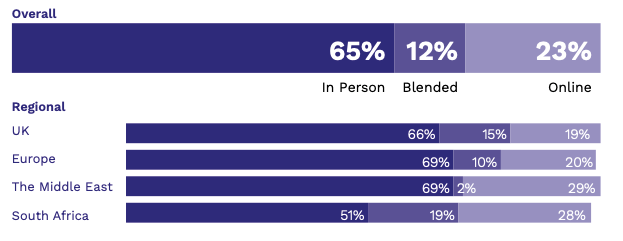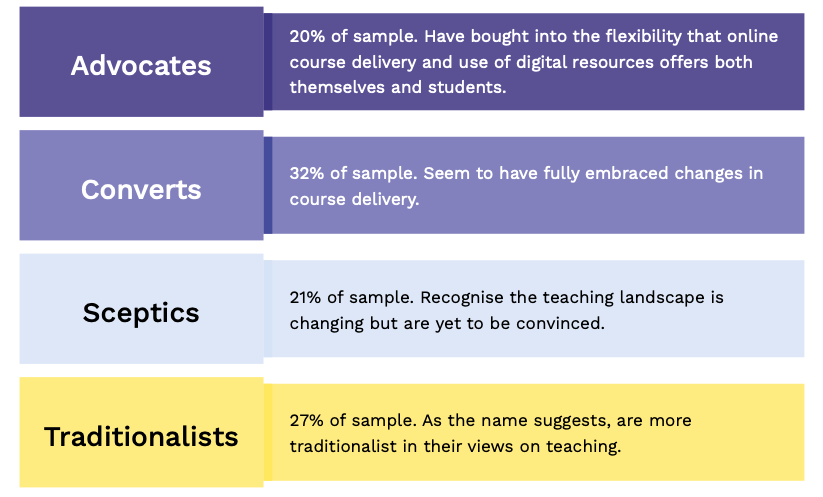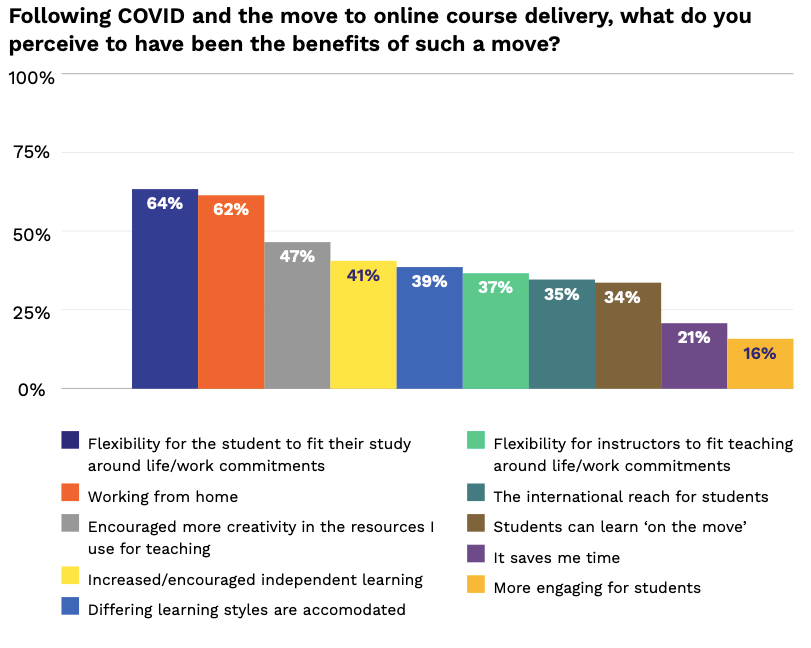
Research covering higher education (HE) instructors’ priorities and challenges in course delivery conducted by education technology company Cengage EMEA indicates that prior to COVID, South Africa had the highest percentage of learners receiving online or blended learning as their main mode of course delivery compared with the UK, Middle East and Europe.
South Africa had a pre-COVID online and blended learning course delivery of 47% compared with the UK at 34%, the Middle East at 31%, and Europe at 30%.
The survey covering 402 HE instructors indicated South Africa having the lowest percentage of In-Person learning at 51% followed by the UK (66%), Europe (69%), and the Middle East (69%) prior to COVID.
Overall, two-thirds of the higher education instructors were delivering their course content in-person pre-COVID, with just a quarter predominantly delivering their course content online.
The results may indicate that SA was moving at a faster pace towards online learning prior to COVID. Another factor could be that in SA, courses are generally much larger, some with thousands taking a course, and therefore online would be better suited for managing very large cohorts.
Segment membership
In the research, Cengage EMEA identified four core instructor segments that the company says go some way to distinguishing attitudes to the use and future use of digital content and delivery in higher education settings. Cengage has called these segments: Advocates, Converts, Sceptics and Traditionalists. The largest group of instructors were designated as ‘converts’ and the second largest group ‘traditionalists’. Each segment shared particular characteristics, as seen below:

Resources Used
Also prior to COVID, it was found that a combination of resources to deliver courses was used, with basic digital resources such as eTextbooks, instructor PowerPoints, and instructor notes, being part of this and used by 77% of the overall sample.
In combination with these basic digital resources, instructors representing half the sample were typically using ‘reading from print textbooks’, ‘lecture notes’, ‘practice questions’, and ‘practical sessions’, alongside journal articles. Journal articles were significantly more likely to be used in the UK (62%) compared to other regions, whilst the UK was also significantly more likely to use published materials (63%) and recorded lectures (38%).
TEACHING PREFERENCES
By the time the study was carried out, COVID-19 had disrupted teaching in most higher education institutions (HEIs) for over a year, forcing many to move their teaching online. The sample was asked: Thinking about your own teaching preferences, how would you prefer to teach your course?
Overall, HE instructors showed a preference for either in-person or a blended mix of online and face-to-face teaching. However, preference differences were noted across the segments, with ‘advocates’ showing a significantly greater preference for in-person teaching and lower for blended.
‘Converts’ showed a significantly higher preference for a blended or online approach to course delivery, whilst ‘traditionalists’ evidenced significantly higher preferences for in-person teaching and much lower preferences for blended or online teaching, suggesting that they are more rigid in their in-person preferences. ‘Sceptics’ showed a lower preference for online only.
Thinking about your own teaching preferences, how would you prefer to teach a course?

Regionally, European instructors showed a significantly greater preference for in-person teaching (62%), whereas those in South Africa show a significantly lower preference for in-person teaching (31%).
Core reasons for preferences:
In-person

- preferred interaction and contact
- can see if students understand the course I’m teaching
- it’s easier to demonstrate something
Blended

- provides flexibility for students
- some aspects need in person interaction
Online

- provides flexibility for students
- flexibility for me to teach around family and personal commitments
THE REALITY OF DELIVERING COURSES USING DIGITAL CONTENT
Understandably, the enforced move for HE institutions to deliver teaching online to their students over the course of the pandemic met with a range of responses. Through the study, Cengage EMEA says it wanted to gauge the perceived benefits and challenges of using digital content to deliver teaching so that education providers and content providers, It can work together to further improve any future experience of this for educators and students alike.
Perceived benefits
The sample highlighted many perceived benefits in making the transition to online course delivery. The main benefits of online course delivery highlighted by instructors included:
- flexibility for students (64%)
- instructors being able to work from home (62%)
- encouraging more creativity in resources used by instructors (47%)
- increasing independent learning (41%).
Following COVID and the move to online course delivery, what do you perceive to have been the benefits of such a move?

Unsurprisingly, the ‘converts’ segment were most likely to perceive a fuller range of benefits than other segments, whilst also noting additional benefits of embracing online course delivery such as accommodating different learning styles, the flexibility for instructors to fit teaching around life-and-work commitments and allowing students to ‘learn on the move’. ‘Traditionalists’ were more likely to perceive fewer benefits of an online mode of teaching.
Perceived drawbacks
When asked about the perceived drawbacks of online course delivery, the most commonly cited drawback will be recognisable to anyone that endured lockdown in some form. Just over a fifth (21%) claimed that the core drawback was the students missing social interaction.
However, they also cited the difficulty in assessing student understanding, which is something that some digital solutions can aid educators with. It is notable that ‘sceptics’ tend to express more drawbacks with online course delivery than the other segments and were more concerned about assessing student understanding and engagement, which, again, digital solutions can offer assistance with.
Across the regions, there was a little discrepancy, with the exception of Africa where ‘broadband issues’ was the key concern for a third of instructors, as well as the perception that students find the use of technology stressful. It is likely that these two issues are related.
Potential concerns
Some wariness to moving courses online, particularly at short notice, is understandable. To gauge this the sample was asked: During COVID, which of the following potential concerns, if any, have you had about delivering online courses?
The main concerns expressed were around students’ motivation and engagement, but also instructors had concerns around their own ability to deliver certain aspects and having to potentially rewrite course content, which is presumably a time issue.
Meeting expectations
That said when asked about the reality of teaching a course using online delivery and resources the experience for just under half of the instructors predominantly met expectations. Whilst almost 4 in 10 agreed that teaching a course using online delivery and digital learning resources was a better experience than they had anticipated.

For those that stated that the experience of teaching a course using online delivery and digital learning resources was better than expected, the reasons given included:
- Students actively engage online / better student engagement (15%)
- Flexibility for students / teachers (9%)
- Students/teachers adapted well (7%)
- The technology worked well (7%)
Although no differences were observed by region, there were differences noted by segment.

‘Sceptics’ significantly more strongly felt that the experience had been worse than they expected (43%), whereas ‘advocates’ and ‘converts’ believed it to be a better experience.
Those who had expressed greater confidence in delivering digital content had a more positive experience (43%), which suggests that familiarity with digital content is beneficial. Where expectations were not exceeded, this is mainly due to initial concerns being realised, lower student engagement; time consuming etc.
This seems to reinforce the view that the more practiced and confident educators are with using digital learning resources, the better their experience and the more likely they are to notice the benefits of using such resources.
So, where does this leave instructors? Online learning is now increasingly important and impactful to the improvement of the teaching and learning experience. To realise the full potential of technology-enhanced learning, help, and support for instructors to develop digital and pedagogical tools to teach effectively both in remote and in-person settings is an imperative factor in course delivery in higher education.



